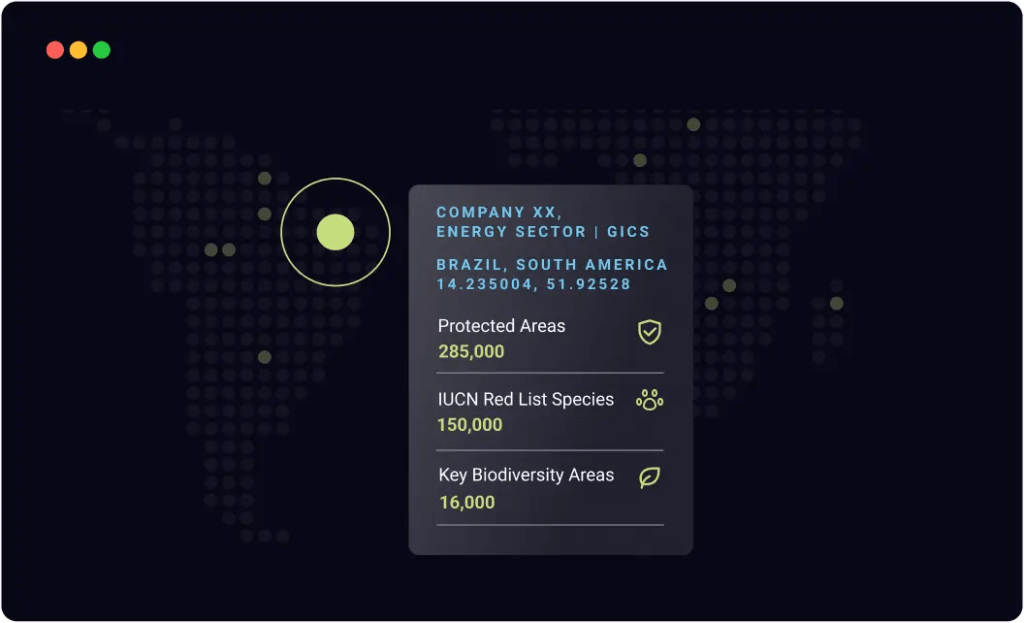IBAT Partnership
RS Metrics’s approach to introducing granular asset-level biodiversity metrics to ESGSignals® platform.
RS Metrics has launched asset-level biodiversity metrics to enhance its leading ESGSignals® platform and collaborated with the Integrated Biodiversity Assessment Tool (IBAT) to provide data about Protected Areas, IUCN Protected Species, and Key Biodiversity Areas
What is IBAT?
IBAT, described by its users as “a must for any project on biodiversity conservation”, provides authoritative geographic information about global biodiversity. It is underpinned by three of the world’s most authoritative global biodiversity datasets and, when integrated into ESGSignals®, will enable users to make biodiversity-informed capital allocation decisions using the most granular biodiversity metrics currently available.
IBAT has been developed and is maintained by the IBAT Alliance, a partnership of leading conservation organizations, including BirdLife International (BirdLife), Conservation International (CI), the International Union for Conservation of Nature (IUCN), and UN Environment Programme World Conservation Monitoring Centre (UNEP-WCMC).
The IBAT collaboration allows users to estimate biodiversity metrics across:
- 265,000 Protected Areas (PAs)
- 142,000 IUCN Red List species
- 16,000 Key Biodiversity Areas (KBAs)

How do ESGSignals® and IBAT work together?
ESGSignals® uses over 100 data sources geospatial datasets and filters them through AssetTracker®.
AssetTracker® is a proprietary global database that serves as the foundation of all RS Metrics products by allowing geospatial data to be mapped to corporate ownership. It provides asset-level geo-location information for the companies in MSCI ACWI Index and includes asset, asset type, corporate ownership, and address for about 5 million asset locations.


ESGSignals® measures the environmental performance and risk of assets such as factories, refineries, and power plants via over 30 metrics, including emissions, land usage, biodiversity, water stress, acute, and chronic physical risk.
IBAT would allow ESGSignals® to provide ever more detailed information about biodiversity measurements that could help investors and companies improve their influence on sustainability and the environment.

How does ESGSignals® Biodiversity data bring benefits to corporate clients?
The collaboration between RS Metrics and IBAT comes at a time when corporates are trying to better understand and estimate the effect that they have on the biodiversity that is situated around their assets.
Recently launched approaches for measuring and disclosing that such as TNFD (Taskforce on Nature-related Financial Disclosures) are expected to be adopted by major governments, corporations, and asset managers, which will further bolster the need for objective biodiversity datasets.
The biodiversity data from ESGSignals® can be used for TNFD’s LEAP assessment method and other reporting processes. It can also provide a look not just into the proximity to important biodiversity locations but also the measurements that show whether a company has had any negative effect on them.

“The World Economic Forum’s Global Risks Report 2020 listed biodiversity loss and ecosystem collapse as one of the top five threats humanity could face in the next ten years. In 2021, BlackRock named natural capital as one of the year’s investment priorities. In tandem, pioneering companies published credible biodiversity strategies with robust biodiversity goals aligned to the Science-Based Targets Network. And major financial institutions, corporates and governments endorsed the launch of the Taskforce on Nature-related Financial Disclosures (TNFD).”

“In our conversations with Wall Street analysts, we have noticed an increasing level of sophistication on climate, environmental, and physical risks,” says Maneesh Sagar, CEO of RS Metrics.
“There is growing awareness of how all the different elements of corporate environmental performance tie together. What this means is that the same beleaguered executives, who are just getting off their heels in responding to emissions, are increasingly having to answer a litany of questions on biodiversity, water stress, physical risk, etc. This pressure will of course only intensify due to what we at RS Metrics call “involuntary transparency”, namely the ability to use geospatial to peer directly into corporate environmental performance. As the general public finds out how poorly current environmental measurements are taken (very rough estimates for emissions, not at all for measures like biodiversity), public scrutiny will only intensify.”
Maneesh Sagar Chairman
and CEO of RS Metrics













